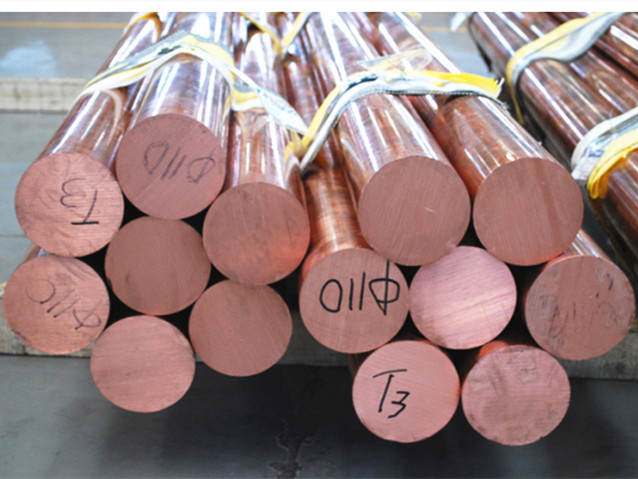The effect of rare earth elements in cooper and its alloy
Rare Earth Elements (REE) is a group of metals for short, which including 17 kinds of Elements: 15 lanthanides, that is lanthanum (La), cerium (Ce), praseodymium (Pr), neodymium (Nd), promethium (Pm), samarium (Sm), europium (Eu), gadolinium (Gd), terbium (Tb), dysprosium (Dy), holmium (Ho), erbium (Er), thulium (Tm), ytterbium (Yb), lutetium (Lu), and two other Elements scandium (Sc) and yttrium (Y). Rare earth elements are almost insoluble in copper, but the addition of a little amount of rare earth elements, whether alone or mixed, is beneficial to the mechanical properties of copper and has little impact on the conductivity of copper. Such elements can form high melting point compounds with impurities such as lead and bismuth in copper and are distributed in grains as fine spherical particles to improve the high-temperature plasticity of copper alloys.
Experimental results show that adding 0.008% mixed rare earth or Y less than 0. L % to copper can significantly improve the mechanical and technological properties of copper. Copper alloys containing 0.01%~0.15% La have better mechanical properties, conductivity and softening resistance than Cu-0.15ag alloys, and have been widely used in electronics, petrochemical, metallurgy, machinery, energy, light industry, environmental protection, agriculture and other fields. Today here we will discuss the effect of rare earth elements on copper and its alloy.
Deoxidized and dehydrogenated
Strong affinity with oxygen, rare earth oxides offer good thermal stability, solid deoxidization products with copper in slag phase liquid surface is removed. Addition of rare earth metal an remove the small amount of oxygen in copper and its alloy obviously. Thermodynamic calculation show that the lanthanum, cerium, praseodymium, rubidium is more strong deoxidizer, their deoxidization ability at high temperature is significantly higher than aluminum and zirconium, also more than beryllium, magnesium, and calcium.
The copper solution is essentially insoluble in N2, CO2, and water vapor, but it’s opposite for O2, SO2, and H2. To hydrogen atoms dissolved in molten copper, rare earth elements are easy to react with hydrogen atomic state generated RH2 type RH3 and the stability of the hydride (R: rare earth element), which strongly exothermic reaction. Because of the small amount of hydrogen dissolved in copper, hydrogen absorbed by rare earth elements and the preference of R – H is a state of solid solution in copper and the alloy after adding rare earth elements, the hydrogen content will not reduce, but the rare earth has formed a stable solid solution, and hydrogen can be avoided under the condition of heating by hydrogen reduction of copper in copper oxide to produce steam to produce hydrogen embrittlement.
During copper processing, the addition of rare earth elements to the dissolved copper melt can quickly absorb and dissolve the hydrogen in the atomic state, and under certain conditions, the hydride with low density and easy to float on the surface of the copper solution can be generated, and under the action of high temperature, the hydrogen can be decomposed again, or it can be oxidized into the slag phase.
Removing impurities
Rare earth has strong chemical activity and can combine with many fusible components to form refractory binary or multiple compounds. They can interact with the low melting point elements sulfur, phosphorus, tin, and lead to combine into a variety of high melting point rare earth compounds or metallic compounds with various atomic ratios, such as Ce3Pb(1200℃) and BiCe3(1400℃), which will remain solid and slag together from the liquid copper, thus to achieve the purpose of removing impurities.
Structure refining
Rare earth elements can reduce or eliminate columnar crystals, refine grains and expand equiaxed crystal regions. The atomic radius of rare-earth elements (0.174nm-0.204nm) is 36% to 60% larger than that of copper (0.127nm). They react with some elements to form high-melting point compounds suspended in solution, which increase the number of grains, reduce the size and diffuse distribution, improve the plasticity and strength of the alloy, and reduce surface cracks and other defects.
For example, the addition of rare earth elements in C28000 copper alloy can refine the as-cast grains, which is conducive to the transition from neutral phase to carbon phase during recrystallization annealing, thus improving the mechanical properties of C28000 brass at room temperature.
Change the shape and distribution of impurities
Rare-earth elements can turn some of the strip, flake, or even block-shaped impurities in metals and alloys into punctate or spheres. For example, the inclusions of beryllium copper alloy are mostly irregular angular Cu2O and Cu2S. When the rare earth element increases to 0.05%, part of the inclusions are spheroidized; when it increases to 0.32%, all of the inclusions are spheroidized. Finally, it can make the impurities evenly distributed throughout the crystal and improve the comprehensive properties of the metal.
In summary, the addition of rare earth elements to copper and copper alloys can form high melting point compounds with oxygen, sulfur, lead, lead, etc. to remove impurities and purify; It can form a stable compound with hydrogen and dissolve in copper in the solid solution state, avoiding “hydrogen embrittlement”. The morphology and distribution of some impurities were changed to improve the metallographic structure, refine the grains, reduce or eliminate the columnar grains, and expand the equiaxed crystal region. These combined changes improve the property of casting, processing, mechanical, welding and corrosion resistance of copper and its alloys.














